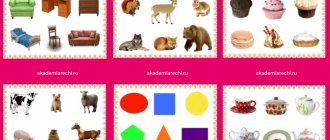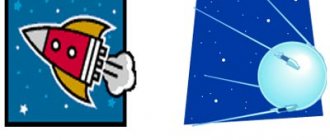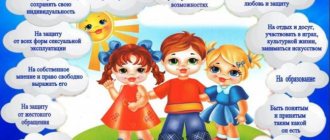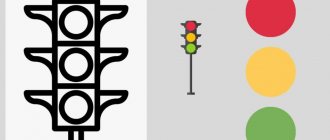MAGAZINE Preschooler.RF
Didactic game “Travelling around the city of Syzran”RELEVANCE:
Play is one of the means of raising and teaching children. How to make the game more effective for developing cognitive interest?
We created a floor game and cubes “Collect the sights of the city” based on local history.
It turned out that the local history and game methods perfectly complement each other, bring variety, promote the creative development of children, increase interest in the history of their hometown, develop imagination, intelligence, and observation. There is an element of competition in them (who is faster, who answers more correctly, who knows more). During the game, preschoolers consolidate their acquired knowledge while enjoying the game.
GAME DESCRIPTION:
The didactic game “Travel around the city of Syzran” is intended for children of senior preschool age and is a fragment of a map measuring 2.5 m by 3 m, which indicates the route of travel around the city of Syzran and a cube measuring 50 cm by 50 cm. The journey starts from the Railway Station and ends with our Kindergarten No. 69 . The route passes through the sights of the city of Syzran.
Goal: consolidate knowledge about your hometown.
Tasks:
Cognitive development:
- Expand children's knowledge about the sights of the city of Syzran, know their names and locations.
- To foster patriotic feelings and love for the small Motherland.
- Continue to introduce the concept of quantity, master the skills of ordinal and quantitative counting, learn to correlate the number (in this case, dots on a cube) with the sign (numbers).
- Teach children to navigate in space
Speech development:
- Improve children's speech as a means of communication, continue to develop the dialogical form of speech.
- Continue teaching children to solve riddles.
- Activate children's vocabulary.
"Social and communicative development"
To develop in children the ability to conduct dialogue with adults and peers; bring up
culture of speech communication. Continue to cultivate friendly relationships between children.
Rules of the game:
The number of participants in this game can be two or more children.
Participants in the game stand at the start and use a dice to play out the order of moves. Then the players take turns.
Each turn, the player rolls the dice and moves forward exactly as many steps as there are dots on the dice.
Designations:
- Red circle “Stop or complete the task!” — to advance further, you must complete the task; if the task is not completed, you skip one move.
- Green circle “Extra turn” - the player rolls the dice again.
- Purple circle “Educational” - the players imagine themselves as tour guides in their hometown, introduce city guests to its sights and memorable places (depending on the task set by the teacher); if the child finds it difficult to answer, then the teacher takes on the role of guide.
The participant who reaches the finish line first will win.
Sample tasks to complete:
Task: the player needs to assemble from puzzles the coat of arms of Syzran, while eliminating the unnecessary ones - elements of other coats of arms (Samara region and Samara).
Task: in front of the player is an album and outline images of the city’s attractions. Task: you need to find a pair, that is, match the contour with the image.
Assignment: You need to look at pictures of animals and birds and determine what is superfluous. At the same time explaining your choice.
Assignment: Cut-out pictures depicting city attractions. It is necessary to put together a picture from memory depicting the sights of your hometown.
Cubes “Collect the sights of the city” .
Goal: To consolidate children's knowledge about the sights of the city.
Game task:
- make a picture from the cubes according to the model.
Didactic task:
- develop attention, memory, thinking, perseverance
- exercise children in making a whole picture from individual parts
- through the content of pictures, consolidate children's knowledge about their hometown
- cultivate love and respect for your hometown.
GAME DESCRIPTION:
The game consists of six dice and pictures of the city's attractions. The teacher and the children look at the pictures. The preschooler names what interesting buildings are depicted on them, and if there is difficulty, the teacher helps. The preschooler chooses a picture to use to assemble the cubes. If a child tries to assemble a picture on his own, this is encouraged with praise. After the picture is collected, the teacher clarifies what the child collected. One child can collect all 6 pictures or collect them one at a time.
| Next > |
Progress of the game: The bear has a den. The squirrel has a hollow.
“Which tree is the leaf from?”
Goal: to consolidate children’s knowledge about the nature of their native land, to consolidate the ability to form relative adjectives (birch - birch, oak - oak, etc.)
Material: Pictures and illustrations of trees, bushes and leaves.
Progress of the game: The teacher shows pictures depicting a leaf, then a tree.
"Green Pharmacy"
Goal: to consolidate children’s knowledge about medicinal plants of their native land; about their correct use for medicinal purposes.
Material: herbarium, card index of medicinal herbs .
Progress of the game: The teacher shows a picture of a medicinal herb, the children guess. The teacher talks about its healing properties.
"Little Red Book"
Goal: to consolidate children’s knowledge about rare plants, animals, birds of our region listed in the “Red Book”
.
Instill love for the homeland , native land, and a sense of responsibility.
Material: “small red book”
, compiled together with
parents , pictures and illustrations depicting rare plants, animals, birds. Progress of the game: The teacher shows a picture depicting rare animals and plants, the children name. The teacher talks about them .
"Countries and Peoples"
Goal: Expand children's understanding of the countries of the Earth and their peoples. To instill an interest in the lives of people with different lifestyles, cultures and traditions. Instill respect for the culture and traditions of different peoples of the world.
Material: globe, map of the World , dolls in national costumes, recordings of melodies of songs of different peoples, pictures and illustrations depicting different countries and peoples of the world.
Progress of the game: The teacher shows a picture depicting different countries and peoples of the world. Talks about them.
“What is the house built from?”
Goal: to improve knowledge of building materials, what a person’s home is made of, the ability to think logically, to consolidate the ability to form an adjective.
Material: Image of different human dwellings.
Progress of the game: Children look at pictures of houses. Word formations: glass - glass, stone - stone.
"Residential - Non-Residential"
Goal: to consolidate children’s knowledge that buildings are residential and non-residential.
People live in residential buildings; in non-residential areas there are organizations, utility rooms, etc.
Material: pictures and illustrations depicting different buildings.
Progress of the game: The teacher suggests identifying residential or non-residential premises: House - residential, store - non-residential...
"Call me kindly"
Goal: to improve children’s speech as a means of communication, to cultivate friendly relationships. Strengthen the ability to form diminutive words, introduce different names. Material: Progress of the game: Misha - Mishenka, Dasha - Dasha, Dashulya.
"I love…"
Goal: to cultivate a respectful , caring attitude towards loved ones, towards each other, develops communication skills.
Progress of the game: The presenter tells the children: “Each of us loves something or someone, all people have this feeling. I love my family, my job, I love you. Tell us who or what you love.” Children talk about their feelings and affections.
“How to find a path to kindergarten?”
Goal: To strengthen children’s ability to navigate the terrain plan, to be able to explain the location of objects in relation to each other. Strengthen the ability to determine the direction of movement. Develop abstract thinking. Material: area plan (neighborhood)
layout of the microdistrict area.
Didactic game “City. Street"
Didactic game “Number. Sign. Subject" on the lexical topic "City. Street"
The game is intended for children aged 4-6 years with severe speech impairments, as well as for children of preschool and primary school age to develop the lexical and grammatical structure of speech.
Didactic game “Number. Sign. Subject" can be used both in individual and subgroup lessons with children.
Target:
This set of games will help an adult teach a child:
- agree nouns with numerals and adjectives in gender, number, case;
- select qualitative, relative, possessive adjectives for nouns;
- use ordinal numbers in speech, coordinate them with nouns and adjectives in gender, number, case;
- activate mental activity, associative thinking;
- make comparative sentences with the conjunction “a”.
Material for the game:
cards with game tasks in two subjects of the same lexical group; playing field and cut cards for independent selection and compilation of a plot series; sets of numbers.
Game description:
Game with ready-made models: each table contains tasks for two subjects of the same lexical group for a larger educational load. At the beginning of the game, the child needs to be clearly shown how associations can be used to indicate the characteristics of objects. For example, how can you depict a bitter taste, show the hardness, softness, juiciness of vegetables, color and shape.
Below are ready-made game cards:
- two large stores;
- seven grocery stores;
- one village store;
- four shoe stores;
- five furniture stores;
- eight flower shops;
- three children's libraries;
- five city schools;
- one music school;
- two sports schools;
- four wooden houses;
- one brick house;
- six block houses;
- five rural schools;
- three city libraries;
- nine paved roads;
- one rural library;
- two sandy roads;
- ten one-story houses;
- three two-story houses;
- one multi-storey building;
- two one-story houses.
The game requires compliance with the following steps:
- Name a word denoting a number (what number? - three).
- Name a word denoting an object (what is this? - library).
- Agree the noun with the numeral in gender (how many libraries? - three cucumbers).
- Name the words denoting the attribute of an object, coordinate them with numerals and nouns in gender, number (three libraries (which ones?) - urban).
- Agree the numeral with the adjectives and nouns in gender and number. (Say in complete sentences, starting with the number. - Three city libraries.)
- Using the same principle, consider another subject of the lexical group - the road.
- Make comparative sentences with the conjunction “a”. (There are three libraries, and nine roads, etc.)
Game with cut cards : played on the same principle as with ready-made models. Only here the child takes an active position and is given more independence.
First, you should invite the child to choose an item on a lexical topic and place it in a sector with an asterisk, then a number (place in the first sector) and select adjectives in the form of picture symbols (place in the longest sector of the playing field). The symbol pictures are first reviewed and what they mean is explained.
To better understand the progress of the game with cut cards, a sample is provided below.
Using the didactic game “Number. Sign. Subject" children will quickly master the skills of agreeing adjectives, nouns and numerals in gender, number, case; will learn to select adjectives for nouns and develop their associative thinking.
The development of associative thinking has a positive effect on the process of memorizing and reproducing necessary information.
On our website you can find other educational games from the “Number” series. Sign. Item". To do this, follow the highlighted link .
We wish everyone success.
Progress of the game: children are guided by the plan and layout.
"Continue the proverb"
Goal: to introduce oral folk word-making, to develop speech, memory, and logical thinking.
Progress of the game: The teacher begins the proverb , the children continue it.
“Birds of our city (region)
»
Goal: to introduce children to the birds of their hometown (region)
.Instill love for
the homeland , native land, the animal world, the desire to help and care. Material: cards with images of birds, album “Birds of our city, region”
, compiled together with
parents .
Progress of the game: The teacher shows the children cards with images of birds, asks them to name and determine whether the bird lives in our city or not.
"Riches of the bowels of the earth"
.
Goal: to expand children’s understanding of the richness of the earth’s interior in minerals (coal, minerals, iron ore, precious stones)
. Expand children's understanding of the internal structure of the earth.
Material: collection of earth's fossils, pictures and illustrations of the earth's natural resources.
Progress of the game - The teacher shows the children a picture (natural fossil)
offers to name it.
"The World of Objects"
Goal: to generalize children’s understanding that in the world around us many objects are made by man from materials of natural or artificial origin (using various materials, a person studies and uses their properties)
.
Foster cognitive activity.
Strengthen the ability to form adjectives. Material: Pictures and images of household items.
My hometown
Didactic board and printed game for children of senior preschool age
Goal
: work to develop patriotic feelings in children, familiarize themselves with the history and sights of their native land, taking into account the requirements of the Federal State Educational Standard for the regional component.
Tasks
:
- form an idea of the history of your city;
- develop children's cognitive interest in the history of their homeland;
- teach the rules of social behavior;
- develop the ability to work in a team;
- develop the emotional sphere of the child’s personality;
- train fine motor skills of the hands;
- train memory, thinking, attention, imagination;
- consolidate children's knowledge about the history of their city of Tsaritsyn-Stalingrad-Volgograd;
- expand your vocabulary, activate your vocabulary.
The game task of the didactic game “My hometown!” is to provide opportunities for children to demonstrate responsibility, independence, and cooperation. The teacher monitors and evaluates the results.
My hometown
Composition of the game: - field-map
This is a playing field-card with pockets on which there are images of the city of Volgograd at different times (when it was called Tsaritsyn, Stalingrad.
- cards
Each card contains three small pictures with views of the central places of the city and attractions in different historical periods time (Note: the places depicted on the map field must match the contents of the cards; the same places at different historical times.)
- chips
Each chip is a round medallion icon with the emblem of the city.
Guidelines for the game
Preliminary work with children must be carried out. It is necessary to talk about the history of the city, about different time stages in its development, about significant events. It is also useful to study the map, mark the city center and main attractions on it. Show how the appearance of the city has changed over time, what the same iconic places for the city look like in different years.
All photographic materials that will form the basis of the printed board game must be studied in advance with the children. After all the materials have been studied, you can begin gaming activities. The game should begin under the guidance of an adult; later, as children master it, they can play independently.
All materials for the game should be located in relation to the players so that they are clearly visible and convenient to use, so it is better to play the game at the table.
Progress of the game
Number of players: subgroup of children from 2 to 8 people.
Children sit down so that everyone can clearly see and conveniently reach and choose a card. The teacher gives each player his own playing field-card with an image of Volgograd at a specific historical time. Children carefully study the picture. Then, independently or with the help of a teacher, they choose a card that depicts the same place in modern times, insert the card into the pocket, comparing one of the three pictures with the card field, and explain their choice.
For a correctly completed task, a participant in the didactic game “My Hometown!” gets a chip. And then he can take another card field for himself. The game ends when all the children have completed the task and there are no free card fields left. The one with the most chips wins. The game can be played several times. When all the children begin to cope with the task easily, the game can be complicated. Invite children (one player or group) to compose a story based on the image.
While using the game “My Hometown!” Children's activities can be organized independently or collectively, with a subgroup of children. Didactic material can be used directly in gaming activities or offered during educational activities (on the topics: development of cognitive and research activities, familiarization with the phenomena of social life). The game helps stimulate children's cognitive interest in the history of their homeland, forms cognitive culture and patriotic consciousness. The didactic material of the game is appropriate for the age of the children and is practical to use when working with children.
Elena Astakhova, teacher of preschool educational institution No. 263, Volgograd









